Apply to Aakash iACST Scholarship Test 2024
NCERT Solutions for Class 10 Maths Chapter 3 Pair of Linear Equations in Two Variables
NCERT Solutions for Class 10 Maths Chapter 3 Pair of Linear Equations in Two Variables
NCERT Solutions for Class 10 Maths Chapter 3 Pair of Linear Equations in Two Variables are discussed here. Class 10 Maths chapter 3 is an important chapter of Algebra and this chapter are created by expert team at careers360 keeping in mind of latest CBSE syllabus 2023. In Class 10 Maths chapter 3 solutions, students will learn to solve the linear equation with two variables. Class 10 Maths chapter 3 NCERT solutions contain the answers of all exercise NCERT questions.
- NCERT Solutions for Class 10 Maths Chapter 3 Pair of Linear Equations in Two Variables
- Class 10 Maths Chapter 3 Pair of Linear Equations in Two Variables PDF Free Download
- Pair of Linear Equations in Two Variables Class 10- Important Formulae
- NCERT Solutions for Class 10 Maths Chapter 3 Pair of Linear Equations in Two Variables (Intext Questions and Exercise)
- Key Features of NCERT Class 10 Maths Solutions Chapter 3
- NCERT Books and NCERT Syllabus
- NCERT Solutions of Class 10 - Subject Wise
- NCERT Exemplar solutions - Subject wise
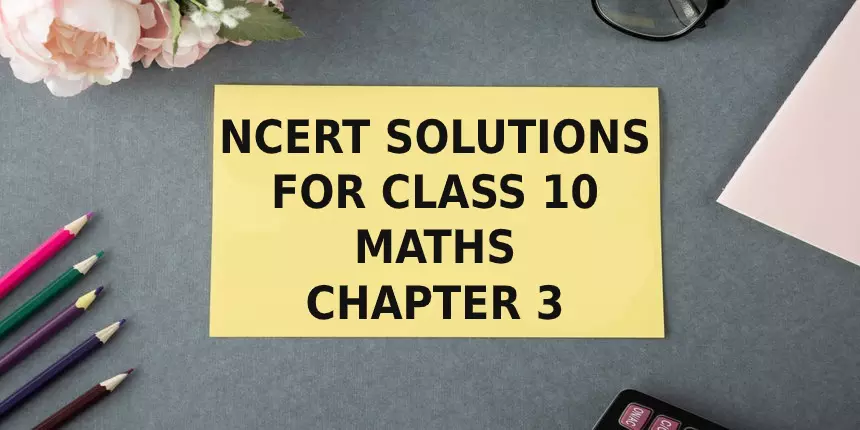
NCERT Class 10 Maths chapter 3 solutions are helpful to know the answers to the questions asked in NCERT class 10 maths book. Apart from this, by going through NCERT solutions for class 10 maths chapter 3, they will come to know about various methods of solving questions. NCERT solutions for class 10 are also available for other subjects.
Also read,
Class 10 Maths Chapter 3 Pair of Linear Equations in Two Variables PDF Free Download
Pair of Linear Equations in Two Variables Class 10- Important Formulae
Types of Linear Equations:
S. No. | Types of Linear Equation | General form | Description | Solutions |
1. | Linear Equation in one Variable | ax + b = 0 | Where a ≠ 0 and a & b are real numbers | One Solution |
2. | Linear Equation in Two Variables | ax + by + c = 0 | Where a ≠ 0 & b ≠ 0 and a, b & c are real numbers | Infinite Solutions possible |
3. | Linear Equation in Three Variables | ax + by + cz + d = 0 | Where a ≠ 0, b ≠ 0, c ≠ 0 and a, b, c, d are real numbers | Infinite Solutions possible |
Simultaneous System of Linear Equations: A pair of equations in the format:
a1x + b1y + c1 = 0
a2x + b2y + c2 = 0
This arrangement is visually depicted through the use of two straight lines on the Cartesian plane, as explained in the following context:
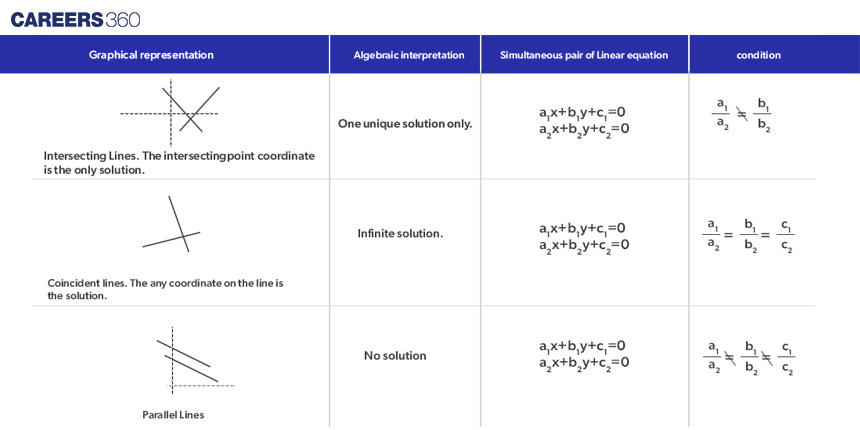
When there is a unique solution then
x/(b1c2 - b2c1) = y/(c1a2 - c2a1) = 1/(a1b2 - a2b2)
This formula can be remembered as the diagram given below
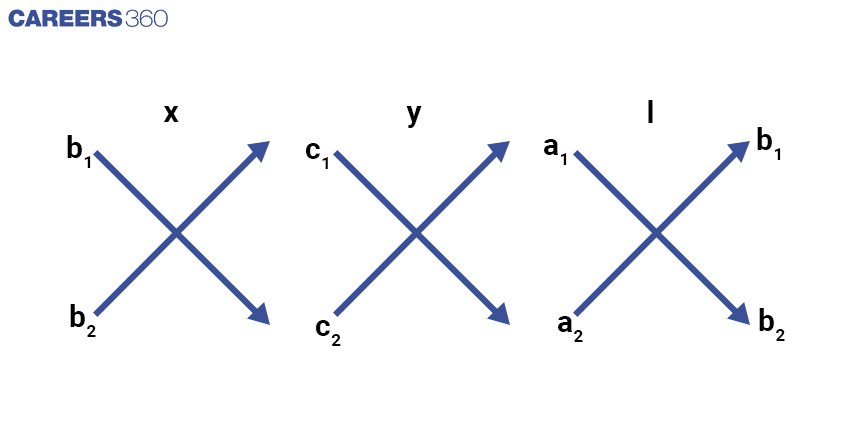
Free download NCERT Solutions for Class 10 Maths Chapter 3 Pair of Linear Equations in Two Variables PDF for CBSE Exam.
NCERT Solutions for Class 10 Maths Chapter 3 Pair of Linear Equations in Two Variables (Intext Questions and Exercise)
Class 10 Maths Chapter 3 solutions Pair of Linear Equations in two variables Excercise: 3.1
Answer: Let x be the age of Aftab and y be the age of his daughter
Now, According to the question,
Also,
Now, let's represent both equations graphically,
From (1), we get
So, Putting different values of x we get corresponding values of y
X | 0 | 7 | -7 |
Y | 6 | 7 | 5 |
And From (2) we get,
So, Putting different values of x we get corresponding values of y
X | 0 | 3 | 6 |
Y | -2 | -1 | 0 |
GRAPH:
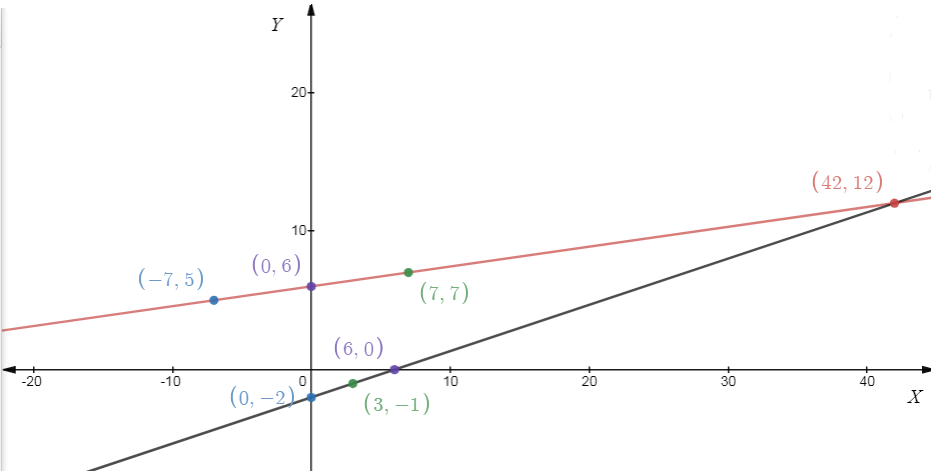
Answer:
Let the price of one Bat be x and the price of one ball be y,
Now, According to the question,
From(1) we have
By putting different values of x, we get different corresponding values of y.So
X | 100 | 300 | -100 |
Y | 600 | 500 | 700 |
Now, From (2), we have,
By putting different values of x, we get different corresponding values of y.So
X | 100 | 400 | -200 |
Y | 400 | 300 | 500 |
GRAPH:
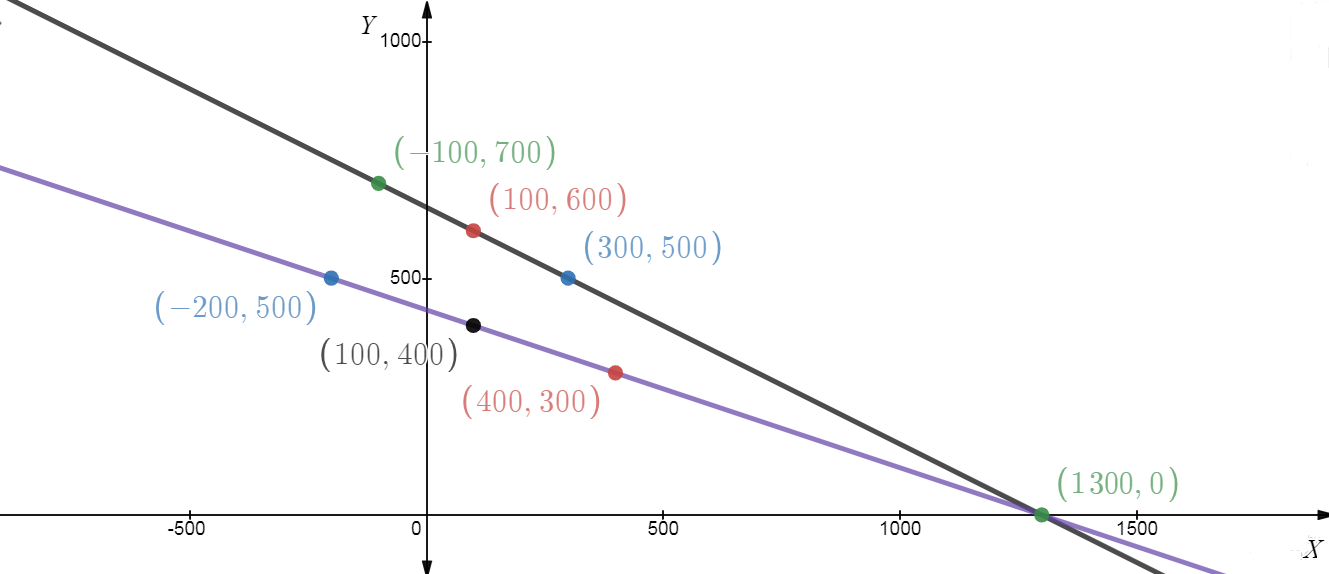
Answer:
Let, x be the cost of 1kg apple and y be the cost of 1kg grapes.
Now, According to the question,
On a day:
After One Month:
Now, From (1) we have
Putting different values of x we get corresponding values of y, so,'
X | 80 | 60 | 50 |
Y | 0 | 40 | 60 |
And From (2) we have,
Putting different values of x we get corresponding values of y, so,
X | 50 | 60 | 70 |
Y | 50 | 30 | 10 |
Graph:
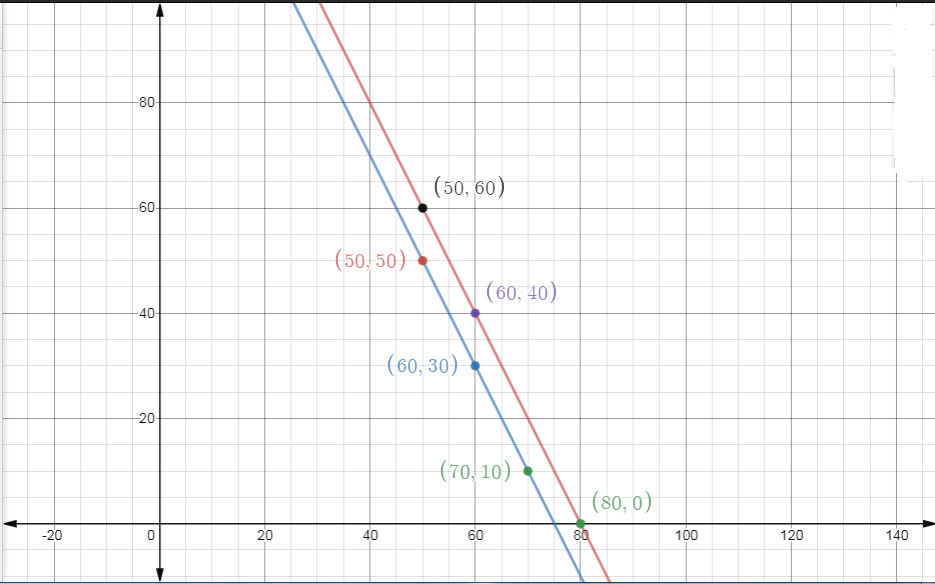
Class 10 Maths Chapter 3 solutions Pair of Linear Equations in Two Variables Excercise: 3.2
Q1 Form the pair of linear equations in the following problems and find their solutions graphically.
Answer:
Let the number of boys is x and the number of girls is y.
Now, According to the question,
Total number of students in the class = 10, i.e.
And
the number of girls is 4 more than the number of boys,i.e.
Different points (x, y) for equation (1)
X | 5 | 6 | 4 |
Y | 5 | 4 | 6 |
Different points (x,y) satisfying (2)
X | 5 | 6 | 7 |
y | 1 | 2 | 3 |
Graph,
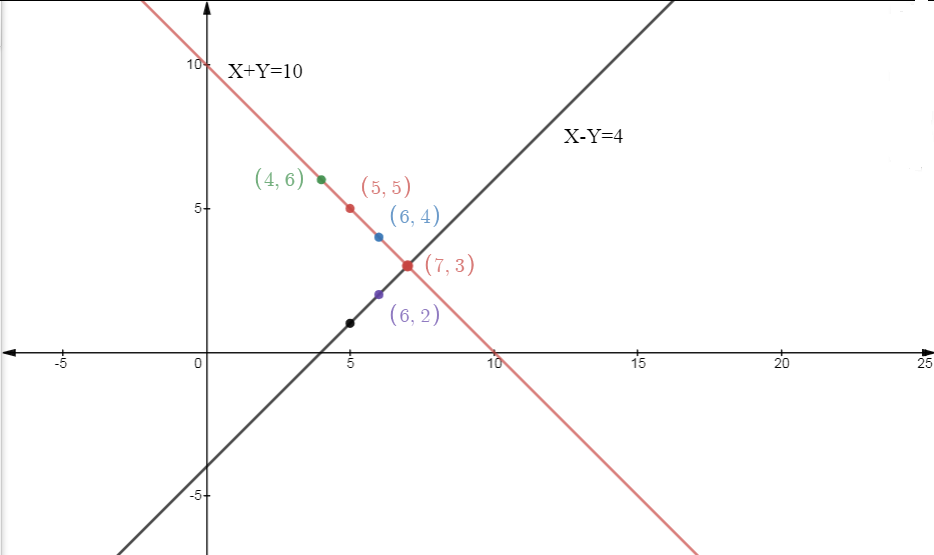
As we can see from the graph, both lines intersect at the point (7,3). that is x= 7 and y = 3 which means the number of boys in the class is 7 and the number of girls in the class is 3.
Q1 Form the pair of linear equations in the following problems and find their solutions graphically.
Answer:
Let x be the price of 1 pencil and y be the price of 1 pen,
Now, According to the question
And
Now, the points (x,y), that satisfies the equation (1) are
X | 3 | -4 | 10 |
Y | 5 | 10 | 0 |
And, the points(x,y) that satisfies the equation (2) are
X | 3 | 8 | -2 |
Y | 5 | -2 | 12 |
The Graph,

As we can see from the Graph, both line intersects at point (3,5) that is, x = 3 and y = 5 which means cost of 1 pencil is 3 and the cost of 1 pen is 5.
Answer:
Give, Equations,
Comparing these equations with , we get
As we can see
It means that both lines intersect at exactly one point.
Answer:
Given, Equations,
Comparing these equations with , we get
As we can see
It means that both lines are coincident.
Q2 On comparing the ratios ,
and
, find out whether the lines representing the following pairs of linear equations intersect at a point, are parallel or coincident: (iii)
Answer:
Give, Equations,
Comparing these equations with , we get
As we can see
It means that both lines are parallel to each other.
Answer:
Give, Equations,
Comparing these equations with , we get
As we can see
It means the given equations have exactly one solution and thus pair of linear equations is consistent.
Answer:
Given, Equations,
Comparing these equations with , we get
As we can see
It means the given equations have no solution and thus pair of linear equations is inconsistent.
Answer:
Given, Equations,
Comparing these equations with , we get
As we can see
It means the given equations have exactly one solution and thus pair of linear equations is consistent.
Answer:
Given, Equations,
Comparing these equations with , we get
As we can see
It means the given equations have an infinite number of solutions and thus pair of linear equations is consistent.
Answer:
Given, Equations,
Comparing these equations with , we get
As we can see
It means the given equations have an infinite number of solutions and thus pair of linear equations is consistent.
Answer:
Given, Equations,
Comparing these equations with , we get
As we can see
It means the given equations have an infinite number of solutions and thus pair of linear equations is consistent.
The points (x,y) which satisfies in both equations are
X | 1 | 3 | 5 |
Y | 4 | 2 | 0 |
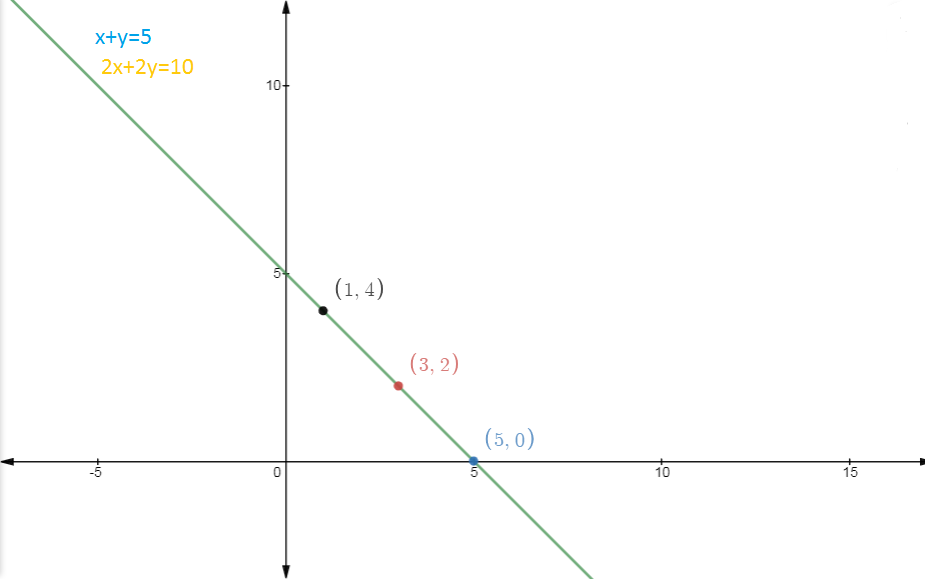
Answer:
Given, Equations,
Comparing these equations with , we get
As we can see
It means the given equations have no solution and thus pair of linear equations is inconsistent.
Answer:
Given, Equations,
Comparing these equations with , we get
As we can see
It means the given equations have exactly one solution and thus pair of linear equations is consistent.
Now The points(x, y) satisfying the equation are,
X | 0 | 2 | 3 |
Y | 6 | 2 | 0 |
And The points(x,y) satisfying the equation are,
X | 0 | 1 | 2 |
Y | -2 | 0 | 2 |
GRAPH:
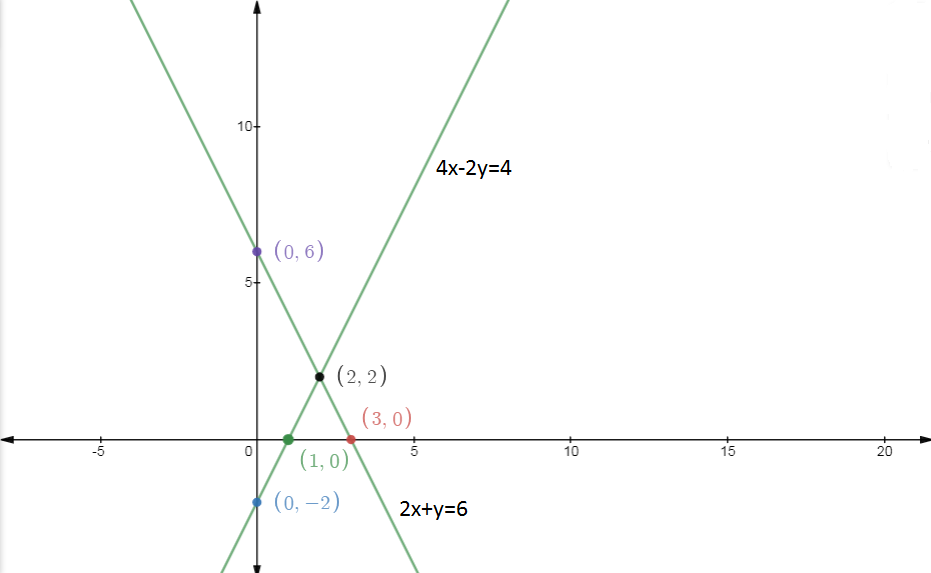
As we can see both lines intersects at point (2,2) and hence the solution of both equations is x = 2 and y = 2.
Answer:
Given, Equations,
Comparing these equations with , we get
As we can see
It means the given equations have no solution and thus pair of linear equations is inconsistent.
Answer:
Let be the length of the rectangular garden and
be the width.
Now, According to the question, the length is 4 m more than its width.i.e.
Also Given Half Parameter of the rectangle = 36 i.e.
Now, as we have two equations, on adding both equations, we get,
Putting this in equation (1),
Hence Length and width of the rectangle are 20m and 16 respectively.
Answer:
Given the equation,
As we know that the condition for the intersection of lines , is ,
So Any line with this condition can be
Here,
As
the line satisfies the given condition.
Answer:
Given the equation,
As we know that the condition for the lines , for being parallel is,
So Any line with this condition can be
Here,
As
the line satisfies the given condition.
Answer:
Given the equation,
As we know that the condition for the coincidence of the lines , is,
So any line with this condition can be
Here,
As
the line satisfies the given condition.
Answer:
Given, two equations,
And
The points (x,y) satisfying (1) are
X | 0 | 3 | 6 |
Y | 1 | 4 | 7 |
And The points(x,y) satisfying (2) are,
X | 0 | 2 | 4 |
Y | 6 | 3 | 0 |
GRAPH:
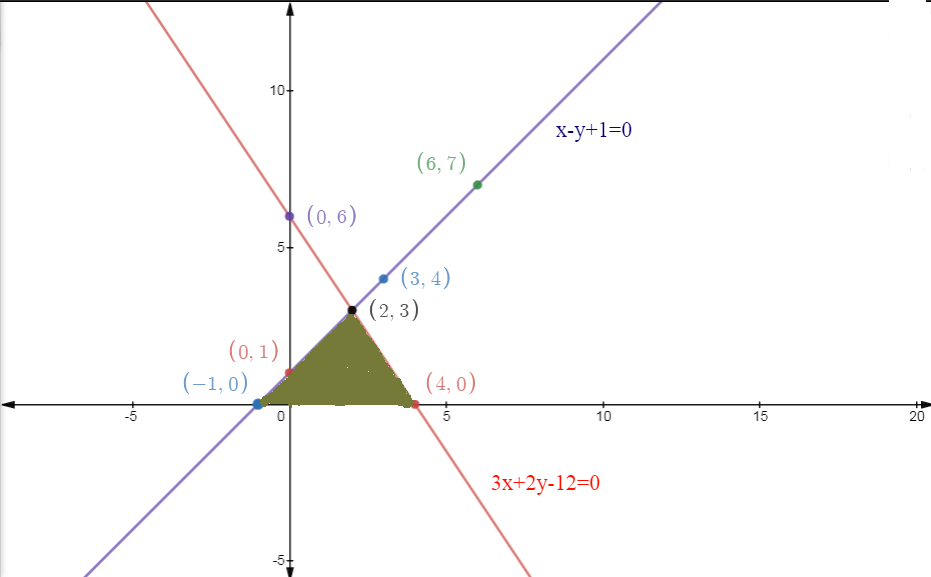
As we can see from the graph that both lines intersect at the point (2,3), And the vertices of the Triangle are ( -1,0), (2,3) and (4,0). The area of the triangle is shaded with a green color.
Pair of linear equations in two variables class 10 solutions Excercise: 3.3
Q1 Solve the following pair of linear equations by the substitution method. (i)
Answer:
Given, two equations,
Now, from (1), we have
Substituting this in (2), we get
Substituting this value of x in (3)
Hence, Solution of the given equations is x = 9 and y = 5.
Q1 Solve the following pair of linear equations by the substitution method (ii)
Answer:
Given, two equations,
Now, from (1), we have
Substituting this in (2), we get
Substituting this value of t in (3)
Hence, Solution of the given equations is s = 9 and t = 6.
Q1 Solve the following pair of linear equations by the substitution method. (iii)
Answer:
Given, two equations,
Now, from (1), we have
Substituting this in (2), we get
This is always true, and hence this pair of the equation has infinite solutions.
As we have
,
One of many possible solutions is .
Q1 Solve the following pair of linear equations by the substitution method. (iv)
Answer:
Given, two equations,
Now, from (1), we have
Substituting this in (2), we get
Substituting this value of x in (3)
Hence, Solution of the given equations is,
.
Q1 Solve the following pair of linear equations by the substitution method. (v)
Answer:
Given, two equations,
Now, from (1), we have
Substituting this in (2), we get
Substituting this value of x in (3)
Hence, Solution of the given equations is,
.
Q1 Solve the following pair of linear equations by the substitution method. (vi)
Answer:
Given,
From (1) we have,
Putting this in (2) we get,
putting this value in (3) we get,
Hence
Q2 Solve and
and hence find the value of ‘
’ for which
.
Answer:
Given, two equations,
Now, from (1), we have
Substituting this in (2), we get
Substituting this value of x in (3)
Hence, Solution of the given equations is,
Now,
As it satisfies ,
Hence Value of m is -1.
(i) The difference between the two numbers is 26 and one number is three times the other. Find them.
Answer:
Let two numbers be x and y and let the bigger number is y.
Now, According to the question,
And
Now, the substituting value of y from (2) in (1) we get,
Substituting this in (2)
Hence the two numbers are 13 and 39.
Answer:
Let the larger angle be x and smaller angle be y
Now, As we know the sum of supplementary angles is 180. so,
Also given in the question,
Now, From (2) we have,
Substituting this value in (1)
Now, Substituting this value of x in (3), we get
Hence the two supplementary angles are
Answer:
Let the cost of 1 bat is x and the cost of 1 ball is y.
Now, According to the question,
Now, From (1) we have
Substituting this value of y in (2)
Now, Substituting this value of x in (3)
Hence, The cost of one bat is 500 Rs and the cost of one ball 50 Rs.
Answer:
Let the fixed charge is x and the per km charge is y.
Now According to the question
And
Now, From (1) we have,
Substituting this value of x in (2), we have
Now, Substituting this value in (3)
Hence, the fixed charge is 5 Rs and the per km charge is 10 Rs.
Now, Fair For 25 km :
Hence fair for 25km is 255 Rs.
Answer:
Let the numerator of the fraction be x and denominator of the fraction is y
Now According to the question,
Also,
Now, From (1) we have
Substituting this value of y in (2)
Substituting this value of x in (3)
Hence the required fraction is
Answer:
Let x be the age of Jacob and y be the age of Jacob's son,
Now, According to the question
Also,
Now,
From (1) we have,
Substituting this value of x in (2)
Substituting this value of y in (3),
Hence, Present age of Jacob is 40 years and the present age of Jacob's son is 10 years.
Pair of linear equations in two variables class 10 solutions Excercise: 3.4
Q1 Solve the following pair of linear equations by the elimination method and the substitution method :
(i)
Answer:
Elimination Method:
Given, equations
Now, multiplying (1) by 3 we, get
Now, Adding (2) and (3), we get
Substituting this value in (1) we, get
Hence,
Substitution method :
Given, equations
Now, from (1) we have,
substituting this value in (2)
Substituting this value of x in (3)
Hence,
Q1 Solve the following pair of linear equations by the elimination method and the substitution method :
(ii)
Answer:
Elimination Method:
Given, equations
Now, multiplying (2) by 2 we, get
Now, Adding (1) and (3), we get
Putting this value in (2) we, get
Hence,
Substitution method :
Given, equations
Now, from (2) we have,
substituting this value in (1)
Substituting this value of x in (3)
Hence,
Answer:
Elimination Method:
Given, equations
Now, multiplying (1) by 3 we, get
Now, Subtracting (3) from (2), we get
Putting this value in (1) we, get
Hence,
Substitution method :
Given, equations
Now, from (2) we have,
substituting this value in (1)
Substituting this value of x in (3)
Hence,
Answer:
Elimination Method:
Given, equations
Now, multiplying (2) by 2 we, get
Now, Adding (1) and (3), we get
Putting this value in (2) we, get
Hence,
Substitution method :
Given, equations
Now, from (2) we have,
substituting this value in (1)
Substituting this value of x in (3)
Hence,
Answer:
Let the numerator of the fraction be x and denominator is y,
Now, According to the question,
Also,
Now, Subtracting (1) from (2) we get
Putting this value in (1)
Hence
And the fraction is
Answer:
Let the age of Nuri be x and age of Sonu be y.
Now, According to the question
Also,
Now, Subtracting (1) from (2), we get
putting this value in (2)
Hence the age of Nuri is 50 and the age of Nuri is 20.
Answer:
Let the unit digit of the number be x and 10's digit be y.
Now, According to the question,
24323
Also
Now adding (1) and (2) we get,
now putting this value in (1)
Hence the number is 18.
Answer:
Let the number of Rs 50 notes be x and the number of Rs 100 notes be y.
Now, According to the question,
And
Now, Subtracting(1) from (2), we get
Putting this value in (1).
Hence Meena received 10 50 Rs notes and 15 100 Rs notes.
Answer:
Let fixed charge be x and per day charge is y.
Now, According to the question,
And
Now, Subtracting (2) from (1). we get,
Putting this in (1)
Hence the fixed charge is 15 Rs and per day charge is 3 Rs.
Pair of linear equations in two variables class 10 solutions Excercise: 3.5
Answer:
Given, two equations,
Comparing these equations with , we get
As we can see,
Hence, the pair of equations has no solution.
Answer:
Given, two equations,
Comparing these equations with , we get
As we can see,
Hence, the pair of equations has exactly one solution.
By Cross multiplication method,
Answer:
Comparing these equations with , we get
As we can see,
Hence, the pair of equations has infinitely many solutions.
Answer:
Given the equations,
Comparing these equations with , we get
As we can see,
Hence, the pair of equations has exactly one solution.
By Cross multiplication method,
Answer:
Given equations,
As we know, the condition for equations to have an infinite solution is
So, Comparing these equations with, , we get
From here we get,
Also,
Now, Subtracting (2) from (1) we get
Substituting this value in (1)
Hence, .
Q2 (ii) For which value of k will the following pair of linear equations have no solution?
Answer:
Given, the equations,
As we know, the condition for equations to have no solution is
So, Comparing these equations with, , we get
From here we get,
Hence, the value of K is 2.
Q3 Solve the following pair of linear equations by the substitution and cross-multiplication methods :
Answer:
Given the equations
By Substitution Method,
From (1) we have
Substituting this in (2),
Substituting this in (3)
Hence .
By Cross Multiplication Method
Answer:
Let the fixed charge be x and the cost of food per day is y,
Now, According to the question
Also
Now subtracting (1) from (2),
Putting this value in (1)
Hence, the Fixed charge is Rs 400 and the cost of food per day is Rs 30.
Answer:
Let numerator of a fraction be x and the denominator is y.
Now, According to the question,
Also,
Now, Subtracting (1) from (2) we get,
Putting this value in (2) we get,
Hence, the fraction is
.
Answer:
Let the number of right answer and wrong answer be x and y respectively
Now, According to the question,
And
Now, subtracting (2) from (1) we get,
Putting this value in (1)
Hence the total number of question is
Answer:
Let the speed of the first car is x and the speed of the second car is y.
Let's solve this problem by using relative motion concept,
the relative speed when they are going in the same direction= x - y
the relative speed when they are going in the opposite direction= x + y
The given relative distance between them = 100 km.
Now, As we know,
Relative distance = Relative speed * time .
So, According to the question,
Also,
Now Adding (1) and (2) we get
putting this in (1)
Hence the speeds of the cars are 40 km/hour and 60 km/hour.
Answer:
Let be the length of the rectangle and
be the width,
Now, According to the question,
Also,
By Cross multiplication method,
Hence the length and width of the rectangle are 17 units and 9 units respectively.
NCERT Solutions for class 10 math chapter 3 Pair of Linear Equations in Two Variables Excercise: 3.6
Q1 Solve the following pairs of equations by reducing them to a pair of linear equations:
Answer:
Given Equations,
Let,
Now, our equation becomes
And
By Cross Multiplication method,
And Hence,
Q1 Solve the following pairs of equations by reducing them to a pair of linear equations:
Answer:
Given Equations,
Let,
Now, our equation becomes
And
By Cross Multiplication method,
So,
.
And hence
Q1 Solve the following pairs of equations by reducing them to a pair of linear equations:
Answer:
Given Equations,
Let,
Now, our equation becomes
And
By Cross Multiplication method,
And Hence,
Q1 Solve the following pairs of equations by reducing them to a pair of linear equations:
Answer:
Given Equations,
Let,
Now, our equation becomes
And
Multiplying (1) by 3 we get
Now, adding (2) and (3) we get
Putting this in (2)
Now,
Hence,
Q1 Solve the following pairs of equations by reducing them to a pair of linear equations: (v)
Answer:
Given Equations,
Let,
Now, our equation becomes
And
By Cross Multiplication method,
And Hence,
Q1 Solve the following pairs of equations by reducing them to a pair of linear equations:
Answer:
Given Equations,
Let,
Now, our equation becomes
And
By Cross Multiplication method,
And Hence,
Q1 Solve the following pairs of equations by reducing them to a pair of linear equations:
(vii)
Answer:
Given Equations,
Let,
Now, our equation becomes
And
By Cross Multiplication method,
Now,
And,
Adding (3) and (4) we get,
Putting this value in (3) we get,
And Hence,
Q1 Solve the following pairs of equations by reducing them to a pair of linear equations:
Answer:
Given Equations,
Let,
Now, our equation becomes
And
Now, Adding (1) and (2), we get
Putting this value in (1)
Now,
And
Now, Adding (3) and (4), we get
Putting this value in (3),
Hence,
Answer:
Let the speed of Ritu in still water be x and speed of current be y,
Let's solve this problem by using relative motion concept,
the relative speed when they are going in the same direction (downstream)= x +y
the relative speed when they are going in the opposite direction (upstream)= x - y
Now, As we know,
Relative distance = Relative speed * time .
So, According to the question,
And,
Now, Adding (1) and (2), we get
Putting this in (2)
Hence,
Hence Speed of Ritu in still water is 6 km/hour and speed of the current is 4 km/hour
Answer:
Let the number of days taken by woman and man be x and y respectively,
The proportion of Work done by a woman in a single day
The proportion of Work done by a man in a single day
Now, According to the question,
Also,
Let,
Now, our equation becomes
And
By Cross Multiplication method,
So,
Answer:
Let the speed of the train and bus be u and v respectively
Now According to the question,
And
Let,
Now, our equation becomes
And
By Cross Multiplication method,
And Hence,
Hence the speed of the train and bus are 60 km/hour and 80 km/hour respectively.
Class 10 math chapter 3 solutions Pair of Linear Equations in Two Variables Excercise: 3.7
Answer:
Let the age of Ani be , age of Biju be
,
Case 1: when Ani is older than Biju
age of Ani's father Dharam:
and
age of his sister Cathy :
Now According to the question,
Also,
Now subtracting (1) from (2), we get,
putting this in (1)
Hence the age of Ani and Biju is 19 years and 16 years respectively.
Case 2:
And
Now Adding (3) and (4), we get,
putting it in (3)
Hence the age of Ani and Biju is 21 years and 24 years respectively.
Answer:
Let the amount of money the first person and the second person having is x and y respectively
Noe, According to the question.
Also
Multiplying (2) by 2 we get,
Now adding (1) and (3), we get
Putting this value in (1)
Thus two friends had 40 Rs and 170 Rs respectively.
Answer:
Let the speed of the train be v km/h and the time taken by train to travel the given distance be t hours and the distance to travel be d km.
Now As we Know,
Now, According to the question,
Now, Using equation (1), we have
Also,
Adding equations (2) and (3), we obtain:
Substituting the value of x in equation (2), we obtain:
Putting this value in (1) we get,
Hence the distance covered by train is 600km.
Answer:
Let the number of rows is x and the number of students in a row is y.
Total number of students in the class = Number of rows * Number of students in a row
Now, According to the question,
Also,
Subtracting equation (2) from (1), we get:
Substituting the value of y in equation (1), we obtain:
Hence,
The number of rows is 4 and the Number of students in a row is 9.
Total number of students in a class
:
Hence there are 36 students in the class.
Q5 In a ,
. Find the three angles.
Answer:
Given,




Also, As we know that the sum of angles of a triangle is 180, so
Now From (1) we have
Putting this value in (2) we have
Putting this in (3)
And
Hence three angles of triangles
Answer:
Given two equations,
And
Points(x,y) which satisfies equation (1) are:
X | 0 | 1 | 5 |
Y | -5 | 0 | 20 |
Points(x,y) which satisfies equation (1) are:
X | 0 | 1 | 2 |
Y | -3 | 0 | 3 |
GRAPH:
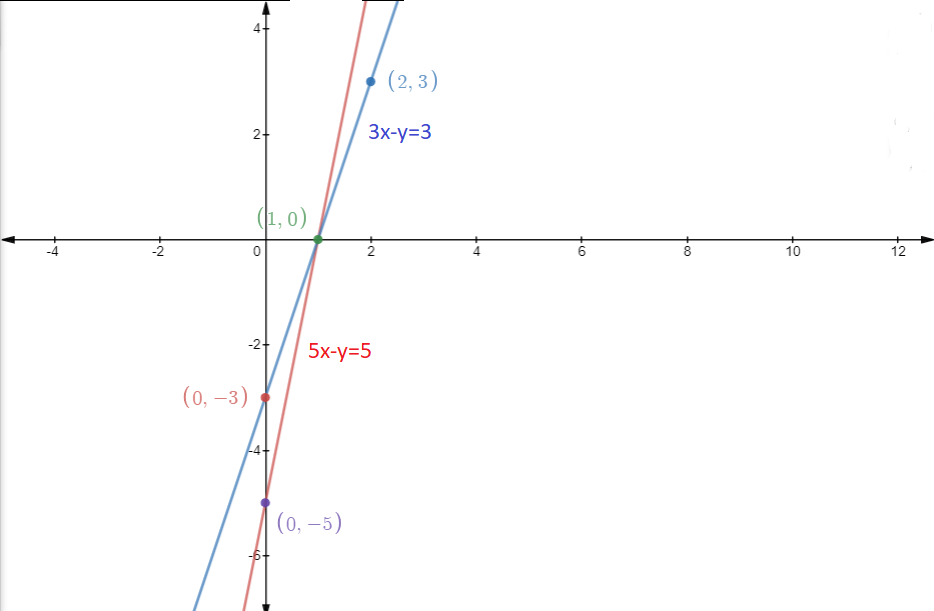
As we can see from the graph, the three points of the triangle are, (0,-3),(0,-5) and (1,0).
Q7 Solve the following pair of linear equations: (i)
Answer:
Given Equations,
Now By Cross multiplication method,
Q7 Solve the following pair of linear equations: (ii)
Answer:
Given two equations,
Now By Cross multiplication method,
Q7 Solve the following pair of linear equations: (iii)
Answer:
Given equation,
Now By Cross multiplication method,
Q7 Solve the following pair of linear equations: (iv)
Answer:
Given,
And
Now, Subtracting (1) from (2), we get
Substituting this in (1), we get,
.
Hence,
Q7 Solve the following pair of linear equations: (v)
Answer:
Given Equations,
As we can see by adding and subtracting both equations we can make our equations simple to solve.
So,
Adding (1) and )2) we get,
Subtracting (2) from (1) we get,
Now, Adding (3) and (4) we get,
Putting this value in (3)
Hence,
Q8 ABCD is a cyclic quadrilateral (see Fig. 3.7). Find the angles of the cyclic quadrilateral.
Answer:
As we know that in a quadrilateral the sum of opposite angles is 180 degrees.
So, From Here,
Also,
Multiplying (1) by 3 we get,
Now,
Subtracting, (2) from (3) we get,
Substituting this value in (1) we get,
Hence four angles of a quadrilateral are :
Class 10 Maths Chapter 3 Topics
Solving a linear equation with two variables.
Representation of linear equation in a graph.
Solutions of linear equations using the graph.
Algebraic interpretation of linear equations.
Formation of linear equations using statements.
Also get the solutions exercise wise-
- Class 10 Maths Chapter 3 Pair of Linear Equations in Two Variables Exercise 3.1
- Class 10 Maths Chapter 3 Pair of Linear Equations in Two Variables Exercise 3.2
- Class 10 Maths Chapter 3 Pair of Linear Equations in Two Variables Exercise 3.3
- Class 10 Maths Chapter 3 Pair of Linear Equations in Two Variables Exercise 3.4
- Class 10 Maths Chapter 3 Pair of Linear Equations in Two Variables Exercise 3.5
- Class 10 Maths Chapter 3 Pair of Linear Equations in Two Variables Exercise 3.6
- Class 10 Maths Chapter 3 Pair of Linear Equations in Two Variables Exercise 3.7
SAT® | CollegeBoard
Registeration closing on 19th Apr for SAT® | One Test-Many Universities | 90% discount on registrations fee | Free Practice | Multiple Attempts | no penalty for guessing
TOEFL ® Registrations 2024
Thinking of Studying Abroad? Think the TOEFL® test. Save 10% on your TOEFL exam with ApplyShop gift cards!
Key Features of NCERT Class 10 Maths Solutions Chapter 3
- The questions and their answers given in Chapter 3 Class 10 Maths NCERT solutions are very interesting and important for board and competitive exams.
- NCERT solutions for Maths chapter 3 Linear Equations in Two Variables Class 10 will help to boost preparation for all of the examinations.
Many real-life situations can be formulated using Mathematical equations given in this chapter 3 NCERT Class 10 Maths solutions.
For example, consider the statement "cost of 1 Kg Apple and 2Kg orange is 120 and the cost of 3 Kg Apple and 1 Kg orange is 210". The statement can be formulated using the Mathematical equation, for this consider the cost of Apple as x and that of orange as y. Then we can write two equations as x+2y=120 and 3x+y=210.
NCERT Books and NCERT Syllabus
NCERT Solutions for Class 10 Maths - Chapter Wise
Solution Link |
NCERT solutions for class 10 maths chapter 3 |
NCERT Solutions of Class 10 - Subject Wise
NCERT Exemplar solutions - Subject wise
How to use NCERT Solutions for Class 10 Maths Chapter 3?
Follow the given tips to make the most of NCERT solutions Class 10 Maths Chapter 3 PDF download:
NCERT solutions Class 10 Maths Chapter 3 are the most important tool when you are appearing for board examinations. 90% paper of CBSE board examinations, directly come from the NCERT.
Now you have done the NCERT solutions for Class 10 Maths chapter 3 and learned the approach to solving questions in the step by step method.
After covering Linear Equations in Two Variables Class 10 solutions you should target the past year papers of CBSE board examinations. The previous year papers will cover the rest 10% part of the Class 10 board exams.
Frequently Asked Question (FAQs)
In Class 10 Maths, a pair of linear equations in two variables is a set of two linear equations that contain two variables, typically represented by x and y. Linear equations are equations of the form ax + by = c, where a, b, and c are constants.
Students can find NCERT solutions for maths to class 10 linear equations in two variables above in this article. Our experts in simple and easy format develop these maths class 10 chapter 3 pair of linear equations in two variables class 10 solutions. These will be very helpful for students.
It is very important to go through Class 10 maths linear equations in two variables questions as they are designed to help you understand the material and practice your problem-solving skills. Students can find ch 3 maths class 10 ncert solutions at careers360 official website. However, it is not necessarily required to work through class 10 chapter 3 maths solutions by every question in order to understand the concepts covered in the chapter.
NCERT class chapter 3 pair of linear equations in two variables class 10 solutions
Contains the concepts of pairs of linear equations and solving them using methods like graphing method, substitution method, elimination method, Consistency and inconsistency of a pair of linear equations, and Dependent and independent linear equations. As Class 10 linear equations in two variables questions are used to solve real-world problems.
In chapter 3 Pair of linear equations class 10 Exercise 3.1, Question 1 is important. All questions in Exercise 3.2 are important. In Exercise 3.3, Question 1 (parts iv, v, vi), Question 2, and Question 3 are important. Exercise 3.4's Question 2 is important, and Exercise 3.5's Questions 2 and 4 are important. All questions in Exercise 3.6 are important. All questions in the optional Exercise 3.7 are important. Students can download a pair of linear equations in two variables class 10 pdf.
Also Read
Articles
Certifications By Top Providers
Explore Top Universities Across Globe
Questions related to CBSE Class 10th
Dear aspirant !
Hope you are doing well ! The class 10 Hindi mp board sample paper can be found on the given link below . Set your time and give your best in the sample paper it will lead to great results ,many students are already doing so .
Hope you get it !
Thanking you
Hello aspirant,
The dates of the CBSE Class 10th and Class 12 exams are February 15–March 13, 2024 and February 15–April 2, 2024, respectively. You may obtain the CBSE exam date sheet 2024 PDF from the official CBSE website, cbse.gov.in.
To get the complete datesheet, you can visit our website by clicking on the link given below.
https://school.careers360.com/boards/cbse/cbse-date-sheet
Thank you
Hope this information helps you.
Hello aspirant,
The paper of class 7th is not issued by respective boards so I can not find it on the board's website. You should definitely try to search for it from the website of your school and can also take advise of your seniors for the same.
You don't need to worry. The class 7th paper will be simple and made by your own school teachers.
Thank you
Hope it helps you.
The eligibility age criteria for class 10th CBSE is 14 years of age. Since your son will be 15 years of age in 2024, he will be eligible to give the exam.
That totally depends on what you are aiming for. The replacement of marks of additional subjects and the main subject is not like you will get the marks of IT on your Hindi section. It runs like when you calculate your total percentage you have got, you can replace your lowest marks of the main subjects from the marks of the additional subject since CBSE schools goes for the best five marks for the calculation of final percentage of the students.
However, for the admission procedures in different schools after 10th, it depends on the schools to consider the percentage of main five subjects or the best five subjects to admit the student in their schools.
Popular CBSE Class 10th Questions
Colleges After 12th
Also Read
Applications for Admissions are open.

JEE Main Important Physics formulas
ApplyAs per latest 2024 syllabus. Physics formulas, equations, & laws of class 11 & 12th chapters

UPES School of Liberal Studies
ApplyRanked #52 Among Universities in India by NIRF | Up to 30% Merit-based Scholarships | Lifetime placement assistance

Aakash iACST Scholarship Test 2024
ApplyGet up to 90% scholarship on NEET, JEE & Foundation courses

JEE Main Important Chemistry formulas
ApplyAs per latest 2024 syllabus. Chemistry formulas, equations, & laws of class 11 & 12th chapters

PACE IIT & Medical, Financial District, Hyd
ApplyEnrol in PACE IIT & Medical, Financial District, Hyd for JEE/NEET preparation

ALLEN JEE Exam Prep
ApplyStart your JEE preparation with ALLEN
